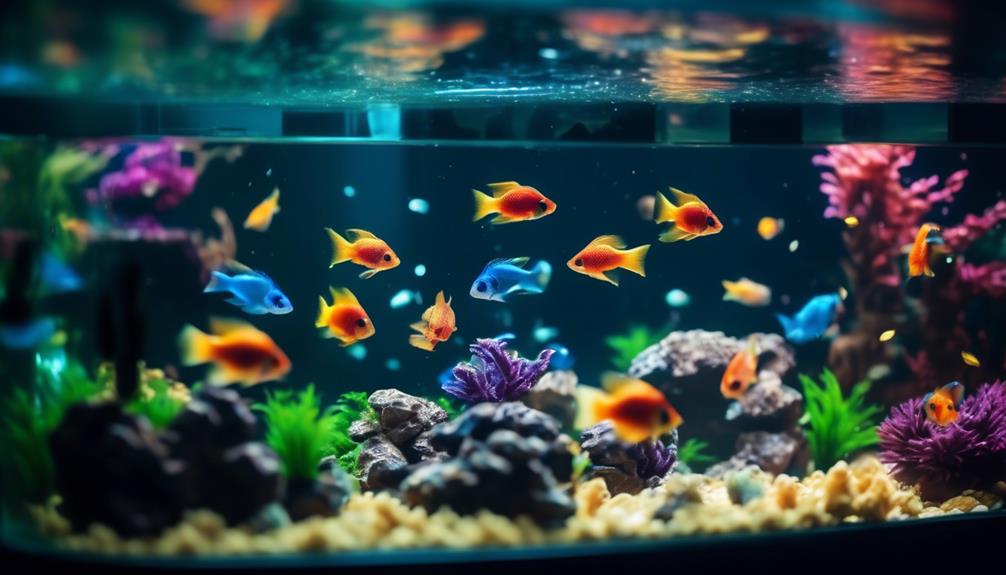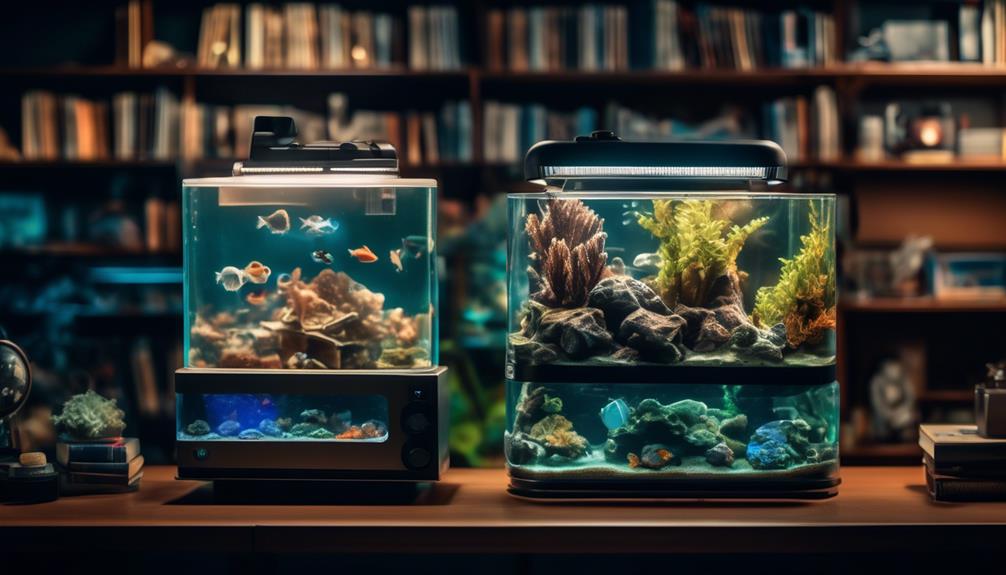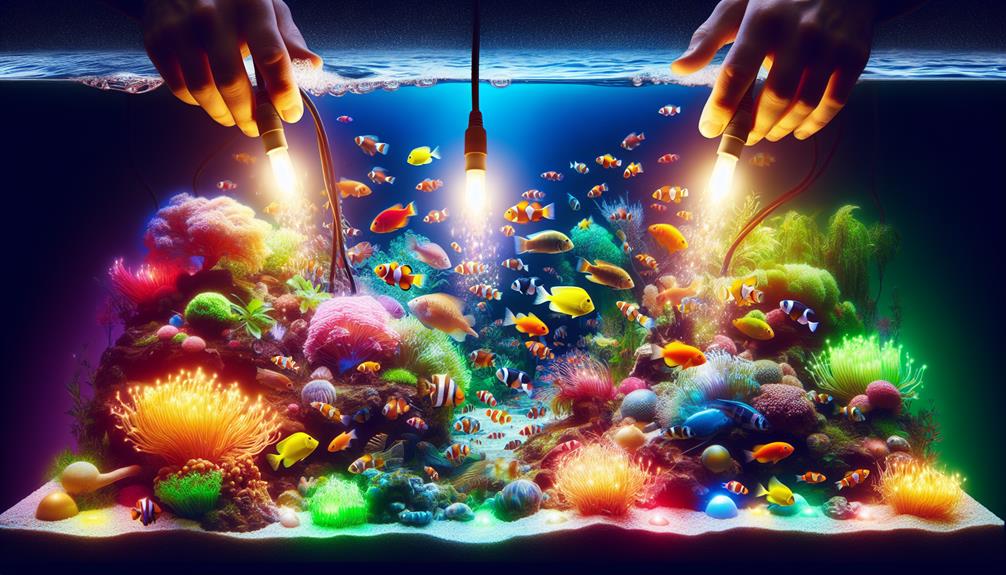Maintaining an optimal temperature in your aquarium is crucial for the well-being of your aquatic inhabitants. A properly functioning heater is the key to achieving this, but selecting the perfect one can be overwhelming.
Fear not, as this article will guide you through the process of choosing the right aquarium heater. From determining the appropriate size to ensuring proper placement and operation, we will cover all the essential factors.
So, whether you're a seasoned enthusiast or just starting out, read on to discover how you can stay one step ahead and provide your aquatic pets with the ideal environment they deserve.
Key Takeaways
- Determine the appropriate size of the aquarium heater based on the rule of thumb of 5 watts per gallon of water, considering factors like the need to raise water temperature and the use of an aquarium lid.
- Proper placement of the aquarium heater is important, with submersible heaters being the most common type. Place the heater next to the filter output or pump for maximum flow and install a thermometer in a corner opposite the heater.
- The aquarium heater should be left on 24/7, as the internal thermostat maintains the water temperature. Ensure the heater is acclimated to the aquarium temperature before plugging it in and always keep it submerged in water.
- When choosing an aquarium heater, opt for a good quality, safe, and reliable brand. Avoid used heaters with unknown histories and look for features such as a digital display, heater guard, adjustable temperature, long power cable, suction cups, and warranty.
Determining the Right Heater Size
Determining the appropriate size of an aquarium heater is essential for maintaining the optimal water temperature for the well-being of your fish and aquatic plants. To calculate the heater wattage needed, a rule of thumb is to use 5 watts of heat per gallon of water. For example, a 29-gallon tank would require a 100-watt heater.
However, it's important to consider other factors such as the use of an aquarium lid, as it can impact the heater's efficiency. A closed lid can trap heat, making the water warmer and potentially reducing the required wattage. On the other hand, an open lid may cause heat loss, requiring a higher wattage heater.
It's also important to take into account colder home temperatures, which may necessitate the use of a second heater. By carefully considering these factors, you can ensure that your aquarium heater is properly sized for optimal performance.
Proper Placement of the Heater
To ensure optimal performance, the proper placement of the aquarium heater is crucial. Here are three key considerations for placing your heater:
- Next to filter output or pump: Placing the heater next to the filter output or pump ensures maximum flow of heated water throughout the aquarium. This helps to maintain a consistent temperature throughout the tank.
- Install a thermometer opposite the heater: Installing a thermometer in a corner opposite the heater allows you to monitor the temperature accurately. This helps you ensure that the heater is working correctly and that the desired temperature is maintained.
- Consider using a heater guard: Using a heater guard provides several benefits. It helps protect your fish from accidental burns and damage from direct contact with the heater. Additionally, it prevents debris from getting trapped in the heater, ensuring its proper functioning.
Regular maintenance is essential for the longevity and efficiency of your heater. Clean the heater regularly, removing any algae or debris that may accumulate. Regularly check and calibrate the temperature settings to ensure accurate heating.
Operating Guidelines for the Heater

Operating the aquarium heater is a straightforward process that ensures the proper temperature maintenance of your aquarium water. To maintain optimal water temperature and prevent heater malfunctions, it is important to follow certain guidelines.
Firstly, it is recommended to leave the heater on 24/7 as the internal thermostat will automatically maintain the desired water temperature. Before plugging in the heater, acclimate it to the aquarium temperature to prevent any sudden temperature fluctuations.
It is crucial to always keep the heater submerged in water to avoid damage or malfunction. During water changes, it is advised to unplug or turn off the power strip to prevent any accidents.
Tips for Choosing the Best Heater
When selecting the optimal aquarium heater, it is essential to consider various factors that contribute to the overall functionality and safety of the device. Here are some tips to help you choose the best heater for your aquarium:
- Choose a reliable brand: Opt for a reputable brand known for producing high-quality and safe aquarium heaters. This will ensure that you are investing in a reliable product that will last.
- Consider heater maintenance: Look for a heater that is easy to clean and maintain. This will make it easier for you to keep the heater in good condition and prevent any malfunctions.
- Take heater safety precautions: Safety should be a top priority when choosing an aquarium heater. Look for features such as automatic shut-off, overheating protection, and a sturdy heater guard. These features will help prevent accidents and ensure the well-being of your fish.
Additional Information and Resources

In order to further enhance your knowledge and understanding of aquarium heaters, it is essential to explore additional information and resources available on the subject.
Aquarium heater safety tips are crucial for ensuring the well-being of your fish and the longevity of your aquarium. These tips include regularly checking the heater for any signs of damage or malfunction, keeping the heater away from any flammable materials, and always unplugging the heater before performing any maintenance or water changes.
Additionally, using a heater controller can provide numerous benefits. A heater controller allows you to accurately regulate and maintain the desired temperature in your aquarium, preventing any fluctuations that could harm your fish. It also offers additional safety features, such as automatic shut-off in case of overheating or electrical issues.
Frequently Asked Questions
Can I Use a Heater That Is Smaller Than the Recommended Wattage for My Aquarium Size?
Using a heater with a wattage lower than recommended for your aquarium size may result in inadequate heating. It is crucial to match the heater wattage to the aquarium size to maintain the desired temperature for the well-being of your aquatic inhabitants.
How Do I Know if My Heater Is Malfunctioning?
Signs of heater malfunction include inconsistent water temperature, heater not turning on/off, or overheating. Troubleshoot by checking power supply, thermostat settings, and ensuring proper submersion. Seek professional assistance if necessary.
Can I Use Multiple Heaters in a Large Aquarium?
Multiple heaters can be used in a large aquarium to provide more even and consistent heating. However, it is important to consider energy consumption and ensure that the heaters are properly placed and controlled to avoid overheating or temperature fluctuations.
Are There Any Safety Precautions I Should Take When Using an Aquarium Heater?
Safety is paramount when using an aquarium heater. Proper installation and maintenance are key. Follow safety tips such as ensuring the heater is submerged, using a reliable brand, and unplugging during water changes to ensure the well-being of your aquatic pets.
Can I Use the Same Heater for Saltwater and Freshwater Aquariums?
Heater compatibility and temperature control are essential factors to consider when using the same heater for saltwater and freshwater aquariums. It is recommended to choose a heater specifically designed for the type of aquarium to ensure optimal performance and the well-being of the aquatic inhabitants.
Conclusion
In conclusion, selecting the perfect aquarium heater is crucial for maintaining the optimal temperature in your aquarium.
By considering factors such as tank size, water temperature needs, and placement, you can ensure a comfortable and healthy environment for your aquatic inhabitants.
Operating the heater efficiently, choosing a reliable brand, and following necessary precautions during water changes are all essential for its effectiveness.
By following these guidelines, aquarium enthusiasts can provide their aquatic pets with a thriving environment they will thrive in.

